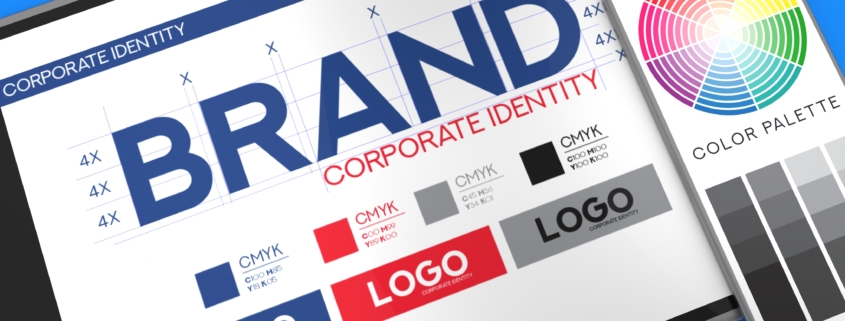What’s a Brand Style Guide and Why Does Your Company Need One?
Why do we spend considerable time and effort helping our clients develop a unique brand style guide? Isn’t it enough to have a mission statement and color scheme? The short answer is no. The long answer involves the many ways that brand identity is the heartbeat of your business, as well as warnings against inauthentic branding.
A well-defined set of brand guidelines connects the consumer to the company in the best way possible. Whether you’re introducing a new brand to the market, or you’re planning a rebranding campaign, you should have a firm grasp on all aspects of your brand identity and brand personality.
In Simple Terms: What is a Brand Style Guide?
A brand style guide is essentially the rule book for how your business and its brand assets will be represented everywhere from business cards to marketing materials to social media. Defining your brand style guide can come down to narrow distinctions of your brand colors (i.e., periwinkle vs. pastel blue), as well as more broad guidance, such as the overarching goals of the brand. It spells out the selection of preferred typography–perhaps Garamond, Georgia, or another closely related sans serif font. In short, the style guide determines the composition of a brand’s visual identity.
It also includes logo design and related iconography, and the overall tone of voice that a company seeks to associate itself with. Is it addressing the sophisticated, affluent shopper with a preference for fine diamonds? Or is the target audience young men who may be jewelry shopping for the first time? Each buyer demands a unique tone and approach.
Establishing Your Brand Voice with a Blog, Imagery, and Community Involvements
This leads us to look at the secondary features of successful brand guidelines. Successful companies breathe life into their brand voice and foster brand consistency by documenting their brand guidelines in a so-called brand catalog or brand book. This is the document that content creators, designers, marketers, and developers can use as a reference to ensure that communication and projects stay on-brand.
- Website design – your website design offers plenty of room for customization that affects user experience and imbues the online presence with a brand’s presence.
- Blog content – it’s not just a matter of blog topics; rather, it also includes the tone of voice the writer uses. Should the writing style be formal and educational or more casual? Do they answer specific questions or provide more general information?
- Social causes – corporate citizenship leads many companies to embrace social causes. Volunteerism, donations, and collaborations are seeing more participation. The causes that a business aligns itself with becomes an integral part of the brand message and brand personality.
Remember: Brand Identity and Advertising are Different Animals
Different advertising campaigns may have varying objectives, but by and large, they are primarily “buy me” messages. They highlight the benefits and advantages of a particular product relative to the competition. In contrast, the content of the brand book opens the door to a brand conversation (and hopefully relationship). It encourages the consumer to trust the messaging that a business conveys. It should nurture the “gut feeling” the shopper follows when choosing one brand over another–even if the products and prices are similar.
Creating the Brand Book
Because a brand style guide is central to overall company identity and consistent messaging, it’s something that a business needs to develop prior to executing advertising campaigns. Brand guidelines will shape the impression made on a first-time shopper. Moreover, they [hopefully] encourage a return visit and loyal customers. Most businesses include at least the following three crucial elements in their books:
- Buyer persona – business classes teach that each product or service has an ideal customer. This theoretical character embodies the age, gender, socioeconomic background, and lifestyle of the target audience. Obviously, companies market differently when appealing to middle-aged women with children vs. young single men. Although the buyer persona may evolve over time, it initially informs the development of marketing collateral and visuals.
- Mission/Vision statement – once we help a company identify its target audience, we work on the reputation it seeks to cultivate. This is intimately connected to the mission or vision of the business and will take some introspection on behalf of the company stakeholders. The mission plays a critical role in brand personality and the nature of interactions with consumers.
- Brand colors and typography – branding relies on the repetition of visual cues, such as colors and text. Your brand style guide should outline the placement and sizing of the logo as well as a permissible use. Usage has to be consistent across sales collateral that goes to print. It must be identical for all displayed signage. Brand colors should be clearly identified (i.e., specific PMS or CMYK codes for print materials, and RGB or Hex for digital materials). Typefaces and fonts should also be uniform.
How to Create and Implement the Style Guide
After defining brand identity and brand personality, it’s critical to put the individual aspects into tangible form. Our clients recognize the importance of digging deep. Branding must inform everything from video scripts for YouTube tutorials to the content of blog posts and tone of voice on the website. Similarly, it must define the names of colors, typefaces, and secondary choices for alternative uses.
Because the goal is reinforcing brand consistency, it must be accessible to anyone who handles and manages the brand:
- Office manager – the individual in charge of ordering signage, flyers, or other marketing collateral must have access to the brand style guide. This professional must look at the specs to verify the use of typeface, space, sizing, and color scheme.
- Fleet manager – for a business with fleet vehicles, it is generally the fleet manager who determines the design and placement of vehicle graphics and wraps. Once again, this manager must have access to the guide and focus on using colors, fonts, text, and the overall feel of the message that is placed on the cars, trucks, or vans.
- Blogger – content creation is a professional field in itself. It requires a thorough understanding of the brand’s target audience and the proper messaging to reach them. It doesn’t matter how creative a blogger might be; if they can’t appeal to the target audience, the posts fall flat.
- Graphic design team – by the very nature of their job, no one works more closely with the brand style guide than the graphic designers. These specialists also create moodboards for the curation of imagery that expresses the feeling the brand should invoke.
- Web designer – web designers work hand in hand with the graphic design team, incorporating the various design elements to influence the feel of individual pages, splash pages, landing pages, CTA’s, etc. The look must be consistent with the brand’s visual identity across the various components of the site. Most importantly, the messaging must come through, no matter where the consumer starts browsing.
Ready to Get Started on a Winning Brand Style Guide?
Telling a brand story is the perfect way to nurture brand personality and encourage consumers to embrace a product. It gives a voice to the item on the shelf and fosters a relationship. We routinely help clients achieve this goal and grow their brand. Contact us today to discuss how we can help strengthen your brand.











